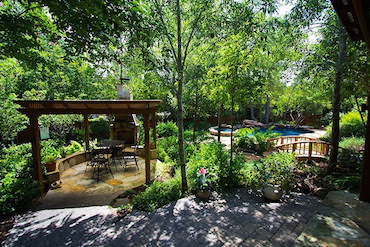- Sections :
- Crime & Public Safety
- Restaurants & Food
- Sports
- More
Three strategies to keep snakes at bay

HOUSTON, Texas - Last March and May, the Houston area experienced heavy rains that produced lush vegetation. This in turn brought about an increase in quail and turkey populations as well as a surge in amphibians, mice, rats and insects. All of these provide a ready food source for snakes, facilitating an expansion in the area of some snake species.
"It's becoming a noticeable issue in suburban neighborhoods," said Mark Seavers, president of Seavers Landscape in Houston, "It's unusual to see this happening in built out areas though." Seavers explains that with expansion of populations, snakes have to go looking for new territory. "There are different grasses that can hide and reveal snakes and easy landscape changes to make your property a less snake-friendly environment," Seavers said.
There have been a few sightings of copperheads, the most common venomous snake in this area. "If your property has any access to a tributary or bayou you may see water moccasins," Seavers said, "mainly in any standing water, even in a pool." Another species common to this area is the Texas Coral, with adjoining red and yellow bands. "Coral snakes are making a comeback this year," Seavers said, "but Southeast Texas is home to over 35 non-venomous species as well, so if you do see a snake it will most likely be non-venomous." Snakes, he points out, are often feared and misunderstood. The vast majority are non-aggressive and only bite if handled.
Seavers recommends three strategies for controlling snakes near your home.
Keep turf cut close - For the lawn, it's important to plant grass that can be cut in a dense matte and holds up well in dry conditions. "Zoysia grass is tolerant and grows much better in shade than St. Augustine and it uses less water," Seavers said. "It's important to keep your water usage down." Close cut turf is ideal because it does not provide snakes with a hiding place. For children's play spaces, Seavers recommends an area of short, dense open turf. "Snakes are reluctant to cross an exposed area that would leave them open to predators," he said.
Eliminate hiding places - It's possible to alter the landscaping to keep snakes away from your home. "Keep dense vegetation on the edge of your property, leaving the middle section exposed," Seavers said, "this forms a layer of protection around the house while pushing snakes out to the margin." Seavers also recommends eliminating plants that snakes like to hide in, such as monkey grass, liriope and irises.
Use sharper edged stones - "In areas where you need to use ground cover," Seavers said, "borrow a page from Xeriscaping by using fractured gravel." Around a pool, a play area or around the foundations of the house, fractured gravel is perfect for deterring snakes. "Snakes prefer the smooth, river-bed stones so sharper gravel will give them pause," Seavers said, "causing them to move to a more desirable area."
Seavers points out that there is a benefit to keeping snakes on the outer edges of the property. "They do keep the rat and mice populations in check," he said. Seavers does not recommend snake repellant. "Repellant is limited in its effectiveness and has to be reapplied," he said. "There are different things you can plant that are not going to afford a ready habitat for snakes."
















